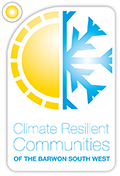Environmental Projects
Adaptation
The region has many examples of climate change adaptation projects, with many focusing on ensuring the region's natural assets are more resilient to climate change. Examples include managing environmental flows of some of the region’s more stressed waterways, protecting and enhancing vulnerable wetlands on the Victorian Volcanic Plains and dune stabilisation works along the region’s coastline to cope to rising sea levels.
There is a need to build on these resilient approaches, while at the same time embracing both transitional and transformational forms of management. Table 1 presents examples of regional projects that are assisting the region to adapt to climate change. Some of these are concerned with resilience building, and some will enable transitions, and ultimately some transformation.
Table 1: Regional examples of climate adaptation projects
| Stakeholder | Name of project/s | Adaptation type | Adaptation Objectives | Further information |
|---|---|---|---|---|
| Corangamite CMA
| The Victorian Volcanic Plains and Western District Lakes Recovery Program and Coastal Saltmarsh Protection Project | Resilience | Promote financial incentives combined with community engagement and capacity building to deliver onground actions to promote natural asset's resilience and adaptability to climate change. Assets targeted include the Western District Lakes Ramsar sites and EPBC listed species and EPBC listed ecological communities, including wetlands, Coastal Saltmarsh and grasslands. |
|
| City of Greater Geelong/ Borough of Queenscliff
| Geelong-Queenscliffe Coastal Adaptation Program | Resilience/ Transition | The project’s main aim is to improve the capacity of the two Councils to use climate assessment information in conjunction with coastal hazard data to assess risk. Determining risk will allow NRM planners to formulate appropriate adaptation responses in terms of planning, asset management and conservation of environmentally sensitive areas. The program has three key phases: - Modelling sea level rise - Identifying and assessing risks - Developing adaptation solutions |
|
| Corangamite CMA | Moorabool Environmental Water Management Plan
| Transition | To improve the Moorabool Rivers flow-dependent ecological values and services through the provision of environmental water. Annual Seasonal Watering Plans are developed to deliver environmental water and consider seasonal and climatic impacts. |
|
| Wannon Water/ Corangamite CMA | Improving Environmental Flows in the Gellibrand River
| Transition | Assess a preferred water supply augmentation option and implementation process to improve critical flows in the Gellibrand River through the summer low flow period. |
Mitigation
The region also has many examples of projects that promote carbon mitigation. Most projects have focused on carbon sequestration, however, there is an increasing shift towards other mitigation practices such as those that reduce emissions. Many past and current projects have operated on a trial basis. This, combined with an unclear carbon market, has led to uncertainty for land managers and private landholders. Examples of regional NRM projects that are promoting carbon mitigation are provided in Table 2.
Table 2: Regional examples of climate mitigation projects
| Stakeholder | Name of project | Carbon sequestration type | Carbon Mitigation Objectives | Further information |
|---|---|---|---|---|
| Corangamite CMA | Corangamite Carbon Capture Recovery Project | Remnant vegetation enhancement/ revegetation | Land managers undertaking revegetation activities in this project also have the opportunity to participate in the Australian Government’s Carbon Farming Initiative (CFI). Landholders receive a figure of estimated carbon sequestration in which they can use as a starting point to enter the carbon market. Sites are prioritised based on carbon sequestration potential, landscape context and other NRM benefits. |
|
| City of Greater Geelong | City of Greater Geelong Urban Forest Strategy 2015 - 2025 | Revegetation | ‘Green the City’ through increased numbers of tree planting (plant out 45,000 vacant nature strips and plant 500 additional advanced trees per annum). ‘Cool the City’ through strategic tree planting (increase canopy cover to 25% leading to reduced temperatures, increase shade and reduced energy use). Engage the community and build regional partnerships (improve community involvement, educate the community and strengthening key tree planting partnerships). Promoting ‘best practice’ urban tree management (improve tree planting consistency across Council, have structurally sound and healthy trees and encourage appropriate species and age diversity of trees). |
|
| Corangamite CMA | The Distribution and Abundance of ‘Blue Carbon’ within Corangamite and Glenelg-Hopkins CMAs | Blue carbon | Four main objectives; 1. Determine the distribution and abundance of blue carbon within the region (coastal) 2. Prioritise areas of blue carbon for conservation 3. Provide regional recommendations for managing areas of blue carbon 4. Provide recommendations for further blue carbon research |
|








